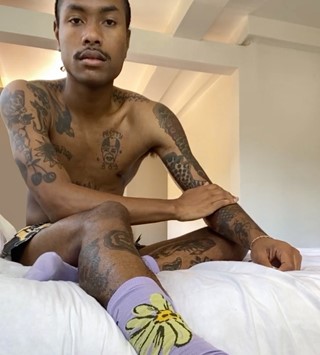Daniel Olatunji of Monad London is creating precious clothing which is far from throwaway. Here, he tells Another Man about his Spring/Summer 2020 collection
- TextMahoro Seward
Name: Daniel Olatunji
Brand: Monad London
Location: London
Alma Mater: Central Saint Martins
USP: Beautifully imperfect tailored garments made with the principles of ‘slow fashion’, crafted in collaboration with artists and artisans
Instagram: @monadlondon
As a student at Central Saint Martins, menswear designer Daniel Olatunji often struggled to complete projects on time. It wasn’t due to the idleness or poor time management you’d typically forgive a student for, but rather an abiding pursuit of ‘perfection’. Seven years on, the clothes he now makes under the banner of Monad London, wrinkled and raw-hemmed, almost suggest that the designer has made an about-turn: even the brand’s logo is a broken circle. “It wasn’t until later on, after I graduated, that I discovered wabi-sabi, which centres on the appreciation of imperfection,” he explains. “It’s there that the real soul of my work lies, in the unstructured appearance and the raw edges.”
Precision, though, remains the guiding force behind the designer’s process, much of which is spent researching and sourcing the rugged textiles that distinguish his work. For Spring/Summer 2020, the familiar antique linens of previous collections return, but it’s the coarse, striped woven fabric that shows Olatunji’s particular dedication to working with textiles which have stories to tell. Composed of yarns collected over years from the ends of various spools, it was handwoven by London-based loom weaver Catarina Riccabona specifically for the collection. In previous seasons, his research has taken him as far as Kano in northern Nigeria, where he worked with Fulani artisanal weavers and indigo dyers at the 600-year-old Kofar Mata dye pits.

Understandably, the textiles he sources and their availability often govern what garments Olatunji makes, and how much he is able to produce. “With handweavers, for example, they’re only going to be able to make small quantities: after all, there are only so many hours in a day,” he says. “When I did the collection using the fabrics produced by the Fulani artisans, I spent a year trying to make it happen. Obviously, you can’t be doing that for every collection in this business, otherwise, you’ll have, well, no business.”
But it’s exactly this painstaking emphasis on sourcing, craftsmanship and, ultimately, rarity that Monad’s clients are after – and makes him a growing name in the ‘slow fashion’ movement (he is also a part of fashion collective 419, where such sustainable principles are central). Many of these clients are based in Japan: “The buyers there seem to appreciate the craftsmanship and the fact that it’s not mass produced far more so than buyers here in Europe,” he says. It’s something echoed by other smaller scale, artisanally focussed brands like Monad London, a good example being the Antwerp-based Jan-Jan Van Essche, whose comparative lack of renown in Europe is counterbalanced by its popularity in Japan.
For Spring/Summer 2020, Olatunji’s offering to his loyal base has broadened, most notably in the form of a sloped-shoulder suede jacket, made from skins with colour imperfections that might otherwise have been discarded. “I’d never worked with leather before, as I’d always thought of it as a specialist area. With a textile, you’re able to stretch or force certain seams, but leather doesn’t allow you to do that,” Olatunji explains. “You have to be really precise: if the seams don’t match up, for example, you can tell in an instant.”

Leather’s not the only new element found in this collection: while Monad London has, until now, relied on a muted palette of indigo, black and grey, this season sees colour arrive in force. “The texture of the antique linens has always reminded me of canvas, so I thought that painting would be a great way to introduce colour into my work,” says Olatunji. And so he offered a jacket, a shirt and a pair of trousers to menswear designer and painter Peter Schamaun. “We had previously collaborated on an idea for a mural, which is repeated on the jacket and the shirt. And when you add the trousers, they act as a continuation of the mural. I prefer working with colour in this way: when a garment has such interesting graphics, your perspective’s distorted, you pay less attention to the silhouette,” the designer says.
While the collection was evidently made with the year’s lighter months in mind, it has a distinctly aseasonal, almost archival feel. “In an ideal world, I wouldn’t be involved in fashion’s seasonal cycle,” he says. “Sure, I might add new shapes each season, but old shapes from previous ones are always there. I just use a different fabric, changing the way the garment falls, even if the base silhouette is still the same.” Against the backdrop of the obsessive production of ‘new’ pieces season-on-season, Olatunji’s slower, subtly sustainable approach to fashion design offers a welcome antidote. Rooted firmly in marketplace-like ethics of small-scale collaborative exchange, Monad London demonstrates the beauty that arises when the supposedly ‘perfect’ industry-standard circle is broken.















